Cost Analysis, Reduction Strategies, and Cash Flow Forecast in Finance
VerifiedAdded on 2023/06/10
|17
|4453
|391
Report
AI Summary
This report provides a comprehensive analysis of cost information for Dysonica, identifying variable, fixed, and semi-variable costs. It explores methods for cost reduction, including activity-based costing, absorption costing, and marginal costing, highlighting their advantages and disadvantages. A 12-month cash flow forecast is prepared to facilitate better spending, cost management, and financial planning. The report evaluates the company's performance based on the budget forecast, considering financial and non-financial implications, as well as external factors impacting the cost base, and concludes with recommendations for the company to improve its financial strategies. Desklib provides similar solved assignments.
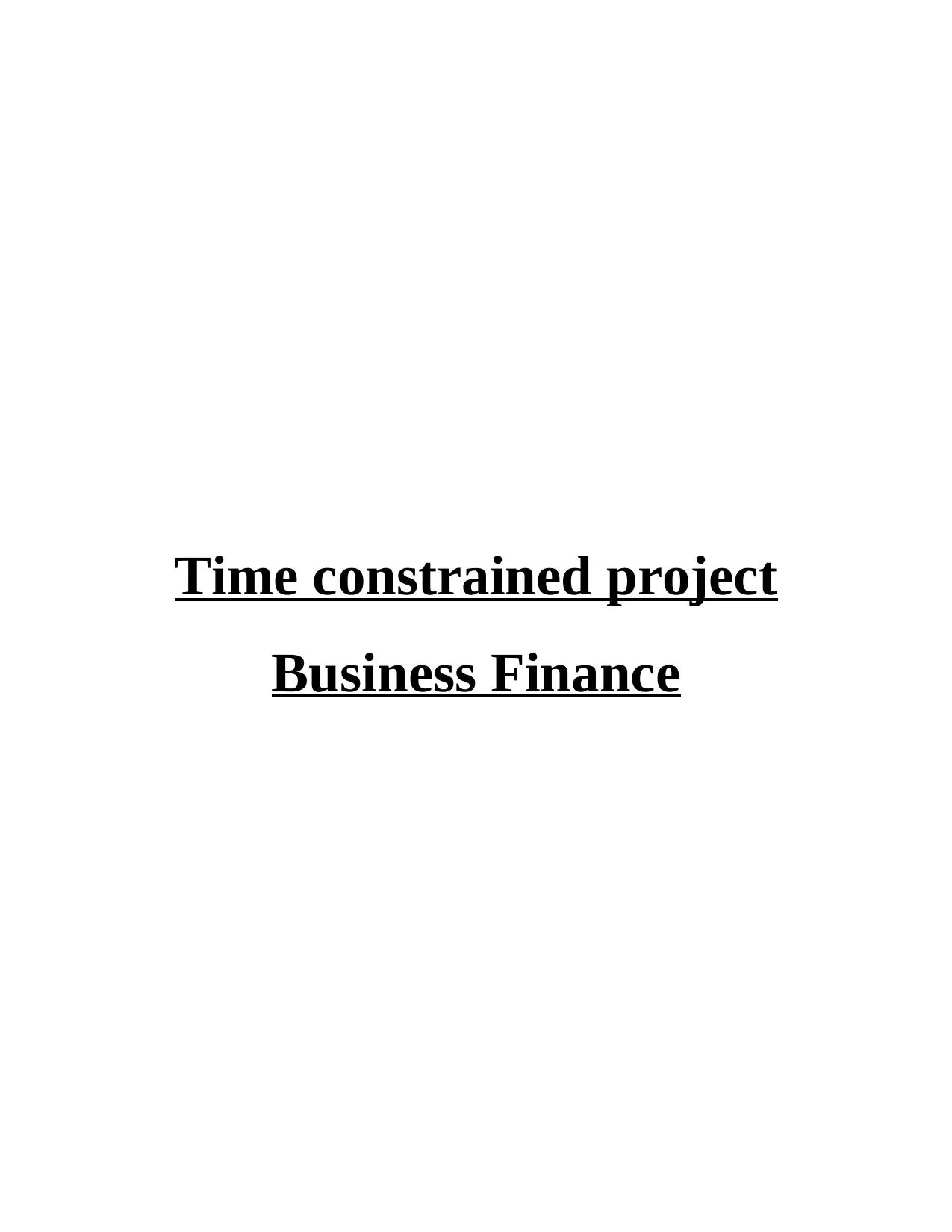
Time constrained project
Business Finance
Business Finance
Paraphrase This Document
Need a fresh take? Get an instant paraphrase of this document with our AI Paraphraser
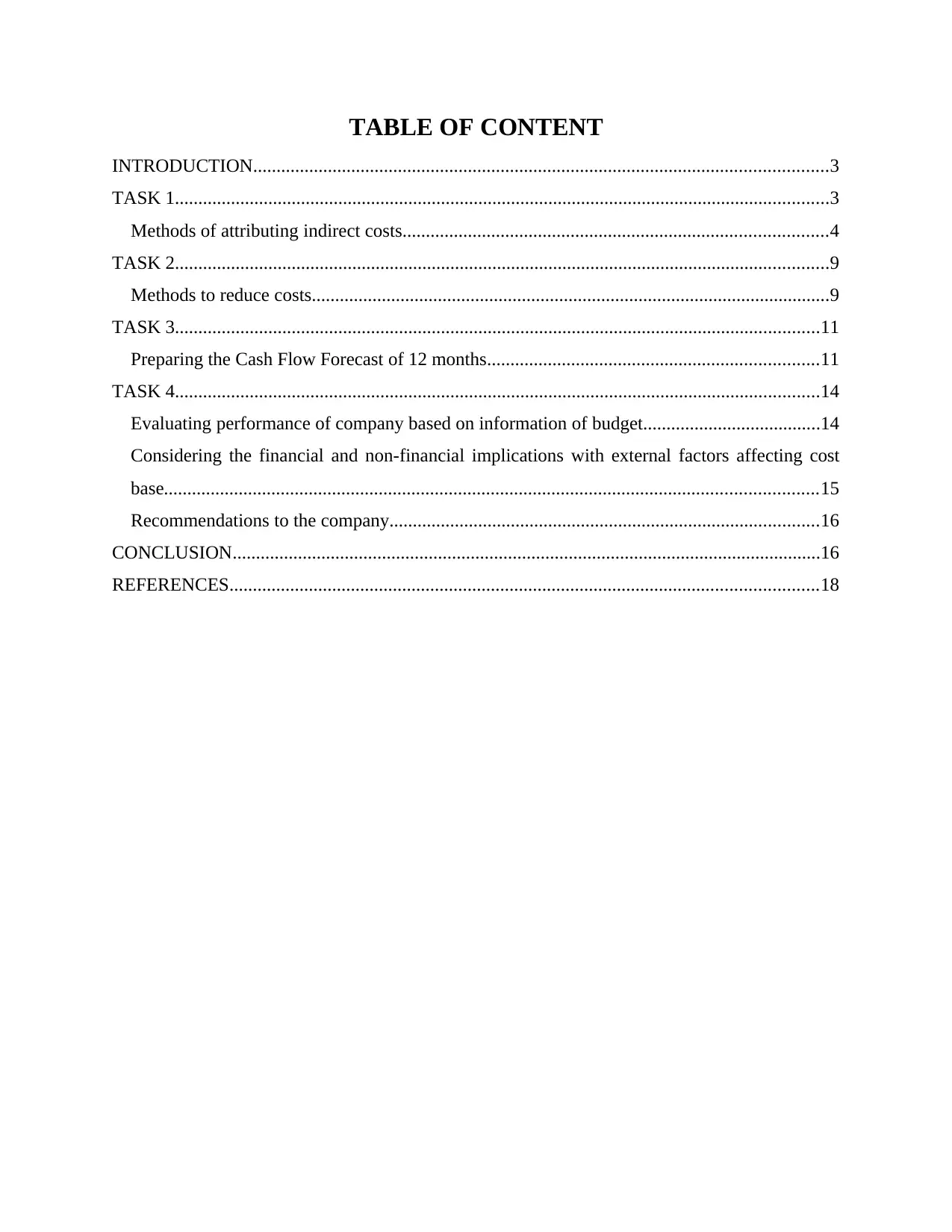
TABLE OF CONTENT
INTRODUCTION...........................................................................................................................3
TASK 1............................................................................................................................................3
Methods of attributing indirect costs...........................................................................................4
TASK 2............................................................................................................................................9
Methods to reduce costs...............................................................................................................9
TASK 3..........................................................................................................................................11
Preparing the Cash Flow Forecast of 12 months.......................................................................11
TASK 4..........................................................................................................................................14
Evaluating performance of company based on information of budget......................................14
Considering the financial and non-financial implications with external factors affecting cost
base............................................................................................................................................15
Recommendations to the company............................................................................................16
CONCLUSION..............................................................................................................................16
REFERENCES..............................................................................................................................18
INTRODUCTION...........................................................................................................................3
TASK 1............................................................................................................................................3
Methods of attributing indirect costs...........................................................................................4
TASK 2............................................................................................................................................9
Methods to reduce costs...............................................................................................................9
TASK 3..........................................................................................................................................11
Preparing the Cash Flow Forecast of 12 months.......................................................................11
TASK 4..........................................................................................................................................14
Evaluating performance of company based on information of budget......................................14
Considering the financial and non-financial implications with external factors affecting cost
base............................................................................................................................................15
Recommendations to the company............................................................................................16
CONCLUSION..............................................................................................................................16
REFERENCES..............................................................................................................................18
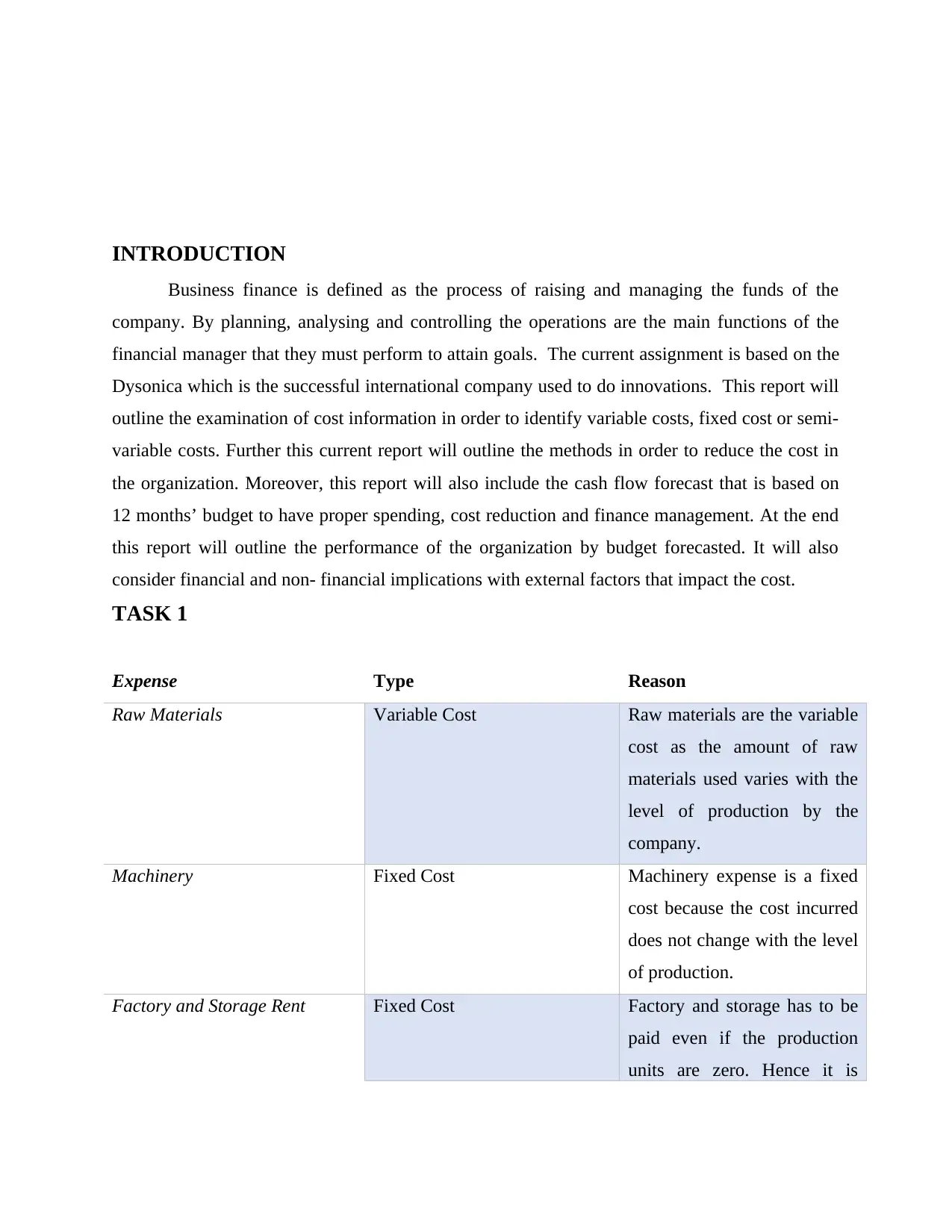
INTRODUCTION
Business finance is defined as the process of raising and managing the funds of the
company. By planning, analysing and controlling the operations are the main functions of the
financial manager that they must perform to attain goals. The current assignment is based on the
Dysonica which is the successful international company used to do innovations. This report will
outline the examination of cost information in order to identify variable costs, fixed cost or semi-
variable costs. Further this current report will outline the methods in order to reduce the cost in
the organization. Moreover, this report will also include the cash flow forecast that is based on
12 months’ budget to have proper spending, cost reduction and finance management. At the end
this report will outline the performance of the organization by budget forecasted. It will also
consider financial and non- financial implications with external factors that impact the cost.
TASK 1
Expense Type Reason
Raw Materials Variable Cost Raw materials are the variable
cost as the amount of raw
materials used varies with the
level of production by the
company.
Machinery Fixed Cost Machinery expense is a fixed
cost because the cost incurred
does not change with the level
of production.
Factory and Storage Rent Fixed Cost Factory and storage has to be
paid even if the production
units are zero. Hence it is
Business finance is defined as the process of raising and managing the funds of the
company. By planning, analysing and controlling the operations are the main functions of the
financial manager that they must perform to attain goals. The current assignment is based on the
Dysonica which is the successful international company used to do innovations. This report will
outline the examination of cost information in order to identify variable costs, fixed cost or semi-
variable costs. Further this current report will outline the methods in order to reduce the cost in
the organization. Moreover, this report will also include the cash flow forecast that is based on
12 months’ budget to have proper spending, cost reduction and finance management. At the end
this report will outline the performance of the organization by budget forecasted. It will also
consider financial and non- financial implications with external factors that impact the cost.
TASK 1
Expense Type Reason
Raw Materials Variable Cost Raw materials are the variable
cost as the amount of raw
materials used varies with the
level of production by the
company.
Machinery Fixed Cost Machinery expense is a fixed
cost because the cost incurred
does not change with the level
of production.
Factory and Storage Rent Fixed Cost Factory and storage has to be
paid even if the production
units are zero. Hence it is
⊘ This is a preview!⊘
Do you want full access?
Subscribe today to unlock all pages.

Trusted by 1+ million students worldwide
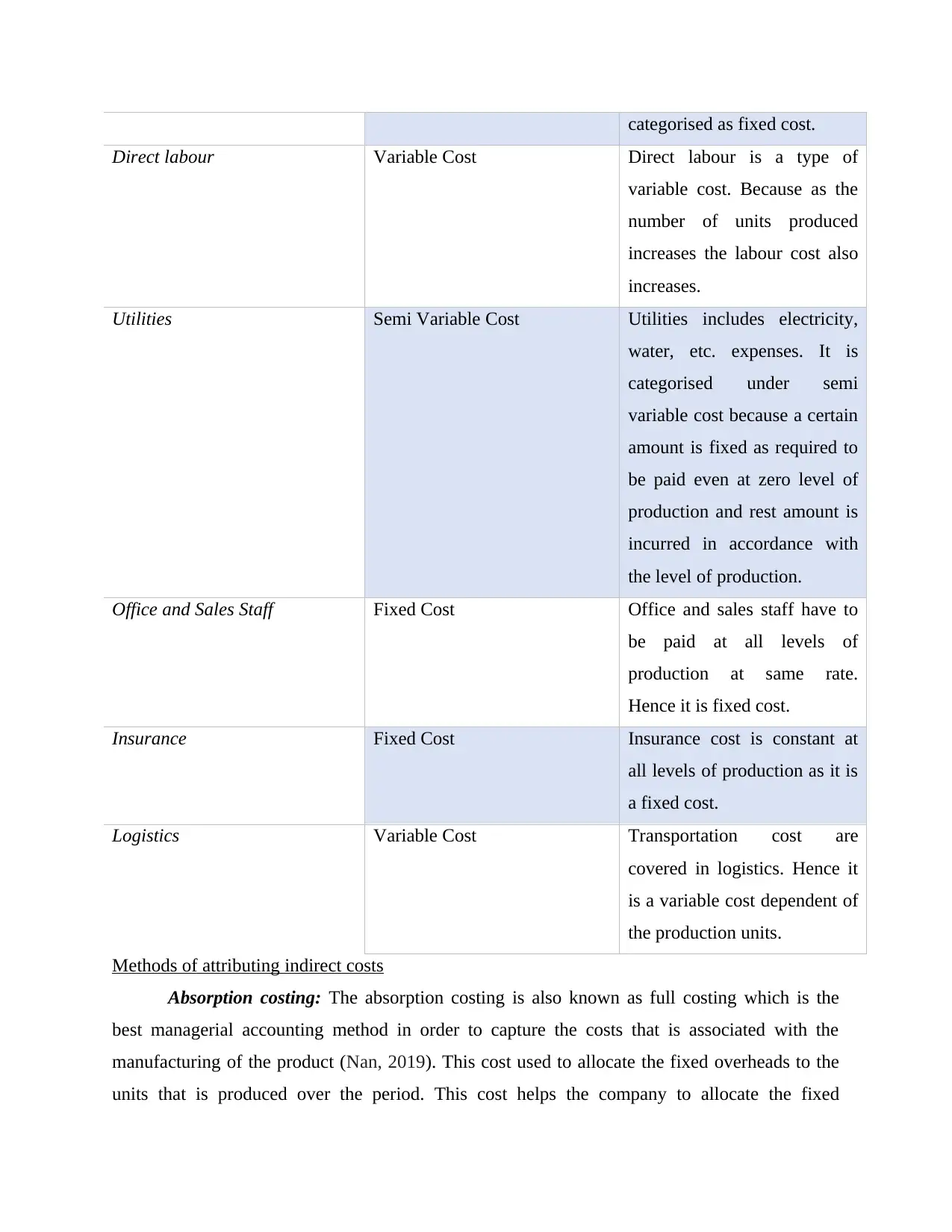
categorised as fixed cost.
Direct labour Variable Cost Direct labour is a type of
variable cost. Because as the
number of units produced
increases the labour cost also
increases.
Utilities Semi Variable Cost Utilities includes electricity,
water, etc. expenses. It is
categorised under semi
variable cost because a certain
amount is fixed as required to
be paid even at zero level of
production and rest amount is
incurred in accordance with
the level of production.
Office and Sales Staff Fixed Cost Office and sales staff have to
be paid at all levels of
production at same rate.
Hence it is fixed cost.
Insurance Fixed Cost Insurance cost is constant at
all levels of production as it is
a fixed cost.
Logistics Variable Cost Transportation cost are
covered in logistics. Hence it
is a variable cost dependent of
the production units.
Methods of attributing indirect costs
Absorption costing: The absorption costing is also known as full costing which is the
best managerial accounting method in order to capture the costs that is associated with the
manufacturing of the product (Nan, 2019). This cost used to allocate the fixed overheads to the
units that is produced over the period. This cost helps the company to allocate the fixed
Direct labour Variable Cost Direct labour is a type of
variable cost. Because as the
number of units produced
increases the labour cost also
increases.
Utilities Semi Variable Cost Utilities includes electricity,
water, etc. expenses. It is
categorised under semi
variable cost because a certain
amount is fixed as required to
be paid even at zero level of
production and rest amount is
incurred in accordance with
the level of production.
Office and Sales Staff Fixed Cost Office and sales staff have to
be paid at all levels of
production at same rate.
Hence it is fixed cost.
Insurance Fixed Cost Insurance cost is constant at
all levels of production as it is
a fixed cost.
Logistics Variable Cost Transportation cost are
covered in logistics. Hence it
is a variable cost dependent of
the production units.
Methods of attributing indirect costs
Absorption costing: The absorption costing is also known as full costing which is the
best managerial accounting method in order to capture the costs that is associated with the
manufacturing of the product (Nan, 2019). This cost used to allocate the fixed overheads to the
units that is produced over the period. This cost helps the company to allocate the fixed
Paraphrase This Document
Need a fresh take? Get an instant paraphrase of this document with our AI Paraphraser
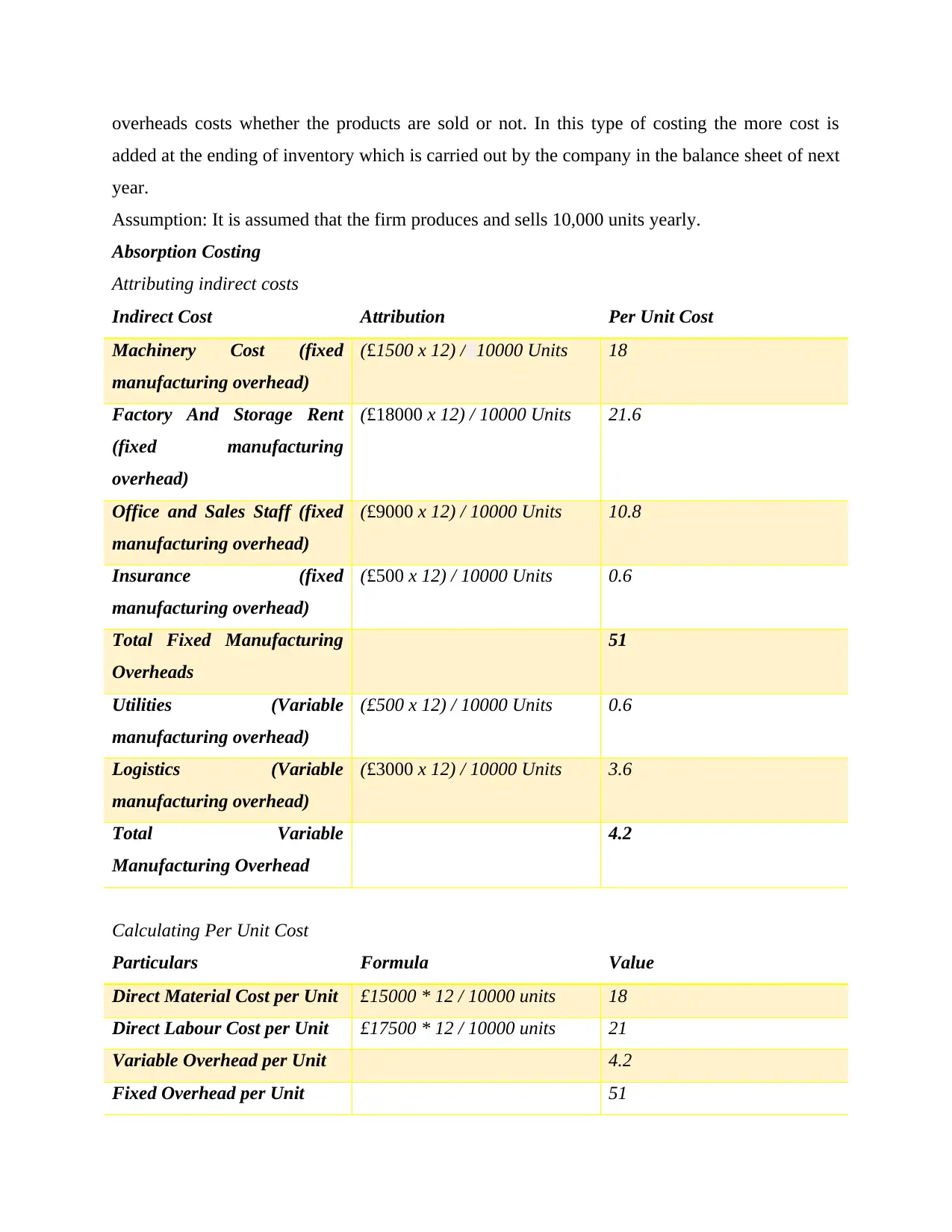
overheads costs whether the products are sold or not. In this type of costing the more cost is
added at the ending of inventory which is carried out by the company in the balance sheet of next
year.
Assumption: It is assumed that the firm produces and sells 10,000 units yearly.
Absorption Costing
Attributing indirect costs
Indirect Cost Attribution Per Unit Cost
Machinery Cost (fixed
manufacturing overhead)
(£1500 x 12) / 10000 Units 18
Factory And Storage Rent
(fixed manufacturing
overhead)
(£18000 x 12) / 10000 Units 21.6
Office and Sales Staff (fixed
manufacturing overhead)
(£9000 x 12) / 10000 Units 10.8
Insurance (fixed
manufacturing overhead)
(£500 x 12) / 10000 Units 0.6
Total Fixed Manufacturing
Overheads
51
Utilities (Variable
manufacturing overhead)
(£500 x 12) / 10000 Units 0.6
Logistics (Variable
manufacturing overhead)
(£3000 x 12) / 10000 Units 3.6
Total Variable
Manufacturing Overhead
4.2
Calculating Per Unit Cost
Particulars Formula Value
Direct Material Cost per Unit £15000 * 12 / 10000 units 18
Direct Labour Cost per Unit £17500 * 12 / 10000 units 21
Variable Overhead per Unit 4.2
Fixed Overhead per Unit 51
added at the ending of inventory which is carried out by the company in the balance sheet of next
year.
Assumption: It is assumed that the firm produces and sells 10,000 units yearly.
Absorption Costing
Attributing indirect costs
Indirect Cost Attribution Per Unit Cost
Machinery Cost (fixed
manufacturing overhead)
(£1500 x 12) / 10000 Units 18
Factory And Storage Rent
(fixed manufacturing
overhead)
(£18000 x 12) / 10000 Units 21.6
Office and Sales Staff (fixed
manufacturing overhead)
(£9000 x 12) / 10000 Units 10.8
Insurance (fixed
manufacturing overhead)
(£500 x 12) / 10000 Units 0.6
Total Fixed Manufacturing
Overheads
51
Utilities (Variable
manufacturing overhead)
(£500 x 12) / 10000 Units 0.6
Logistics (Variable
manufacturing overhead)
(£3000 x 12) / 10000 Units 3.6
Total Variable
Manufacturing Overhead
4.2
Calculating Per Unit Cost
Particulars Formula Value
Direct Material Cost per Unit £15000 * 12 / 10000 units 18
Direct Labour Cost per Unit £17500 * 12 / 10000 units 21
Variable Overhead per Unit 4.2
Fixed Overhead per Unit 51
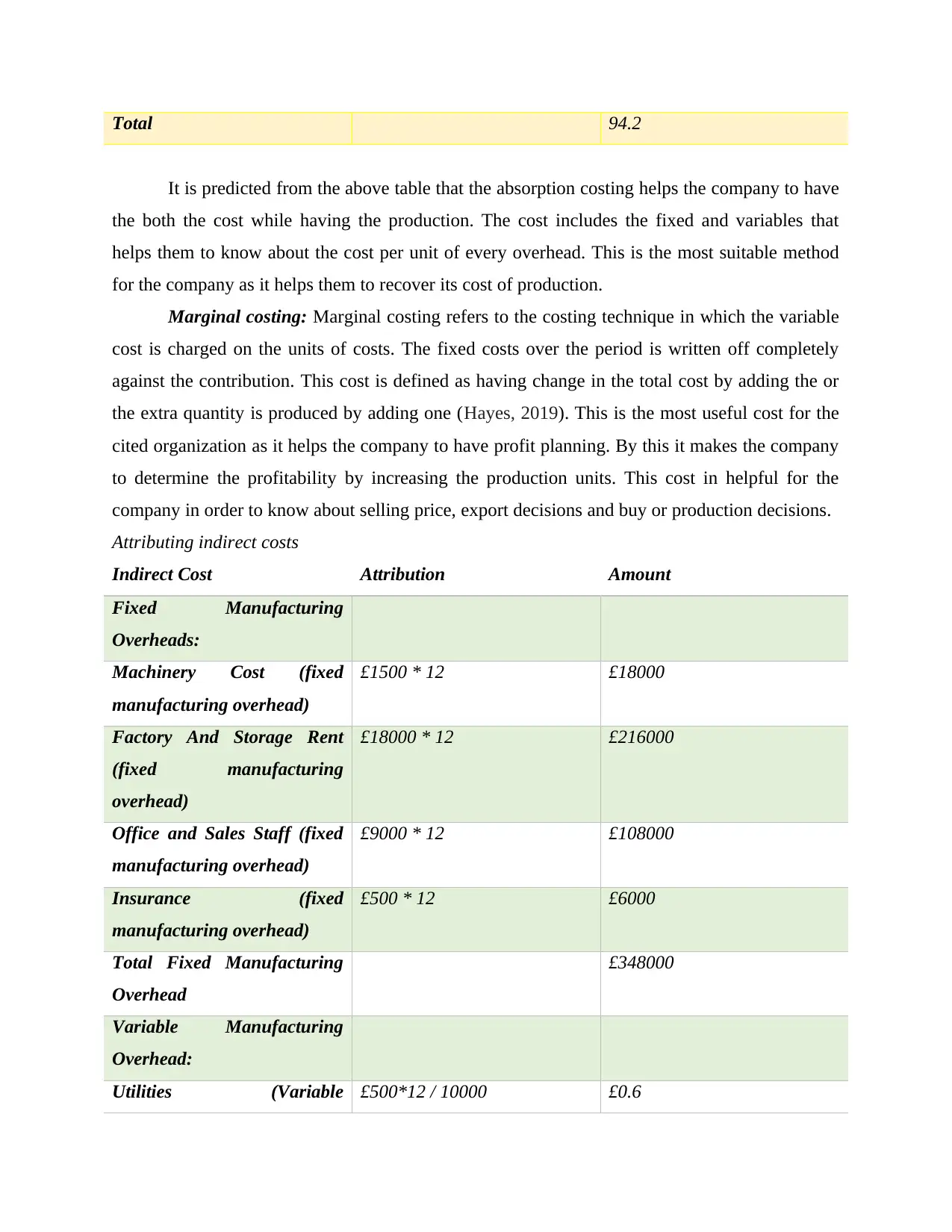
Total 94.2
It is predicted from the above table that the absorption costing helps the company to have
the both the cost while having the production. The cost includes the fixed and variables that
helps them to know about the cost per unit of every overhead. This is the most suitable method
for the company as it helps them to recover its cost of production.
Marginal costing: Marginal costing refers to the costing technique in which the variable
cost is charged on the units of costs. The fixed costs over the period is written off completely
against the contribution. This cost is defined as having change in the total cost by adding the or
the extra quantity is produced by adding one (Hayes, 2019). This is the most useful cost for the
cited organization as it helps the company to have profit planning. By this it makes the company
to determine the profitability by increasing the production units. This cost in helpful for the
company in order to know about selling price, export decisions and buy or production decisions.
Attributing indirect costs
Indirect Cost Attribution Amount
Fixed Manufacturing
Overheads:
Machinery Cost (fixed
manufacturing overhead)
£1500 * 12 £18000
Factory And Storage Rent
(fixed manufacturing
overhead)
£18000 * 12 £216000
Office and Sales Staff (fixed
manufacturing overhead)
£9000 * 12 £108000
Insurance (fixed
manufacturing overhead)
£500 * 12 £6000
Total Fixed Manufacturing
Overhead
£348000
Variable Manufacturing
Overhead:
Utilities (Variable £500*12 / 10000 £0.6
It is predicted from the above table that the absorption costing helps the company to have
the both the cost while having the production. The cost includes the fixed and variables that
helps them to know about the cost per unit of every overhead. This is the most suitable method
for the company as it helps them to recover its cost of production.
Marginal costing: Marginal costing refers to the costing technique in which the variable
cost is charged on the units of costs. The fixed costs over the period is written off completely
against the contribution. This cost is defined as having change in the total cost by adding the or
the extra quantity is produced by adding one (Hayes, 2019). This is the most useful cost for the
cited organization as it helps the company to have profit planning. By this it makes the company
to determine the profitability by increasing the production units. This cost in helpful for the
company in order to know about selling price, export decisions and buy or production decisions.
Attributing indirect costs
Indirect Cost Attribution Amount
Fixed Manufacturing
Overheads:
Machinery Cost (fixed
manufacturing overhead)
£1500 * 12 £18000
Factory And Storage Rent
(fixed manufacturing
overhead)
£18000 * 12 £216000
Office and Sales Staff (fixed
manufacturing overhead)
£9000 * 12 £108000
Insurance (fixed
manufacturing overhead)
£500 * 12 £6000
Total Fixed Manufacturing
Overhead
£348000
Variable Manufacturing
Overhead:
Utilities (Variable £500*12 / 10000 £0.6
⊘ This is a preview!⊘
Do you want full access?
Subscribe today to unlock all pages.

Trusted by 1+ million students worldwide
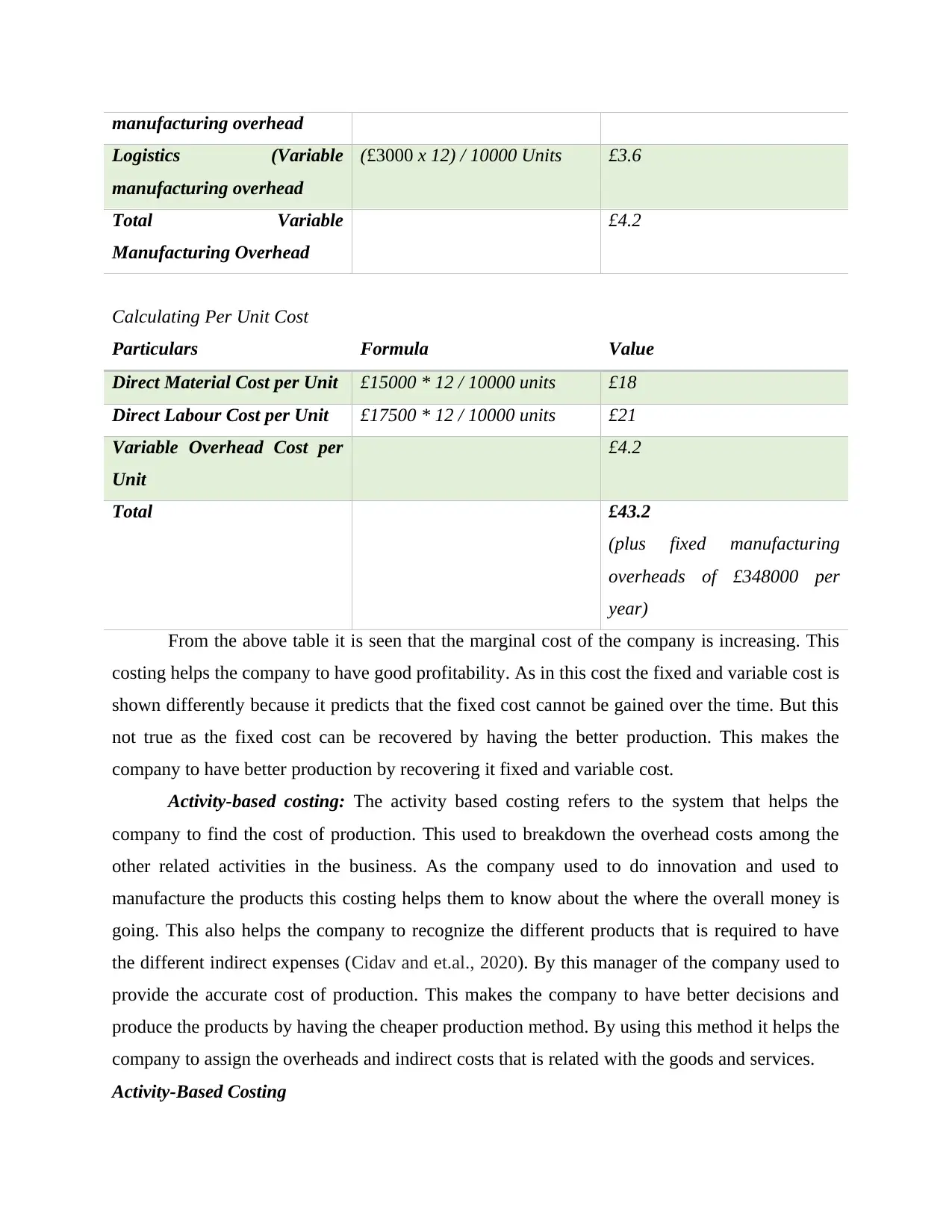
manufacturing overhead
Logistics (Variable
manufacturing overhead
(£3000 x 12) / 10000 Units £3.6
Total Variable
Manufacturing Overhead
£4.2
Calculating Per Unit Cost
Particulars Formula Value
Direct Material Cost per Unit £15000 * 12 / 10000 units £18
Direct Labour Cost per Unit £17500 * 12 / 10000 units £21
Variable Overhead Cost per
Unit
£4.2
Total £43.2
(plus fixed manufacturing
overheads of £348000 per
year)
From the above table it is seen that the marginal cost of the company is increasing. This
costing helps the company to have good profitability. As in this cost the fixed and variable cost is
shown differently because it predicts that the fixed cost cannot be gained over the time. But this
not true as the fixed cost can be recovered by having the better production. This makes the
company to have better production by recovering it fixed and variable cost.
Activity-based costing: The activity based costing refers to the system that helps the
company to find the cost of production. This used to breakdown the overhead costs among the
other related activities in the business. As the company used to do innovation and used to
manufacture the products this costing helps them to know about the where the overall money is
going. This also helps the company to recognize the different products that is required to have
the different indirect expenses (Cidav and et.al., 2020). By this manager of the company used to
provide the accurate cost of production. This makes the company to have better decisions and
produce the products by having the cheaper production method. By using this method it helps the
company to assign the overheads and indirect costs that is related with the goods and services.
Activity-Based Costing
Logistics (Variable
manufacturing overhead
(£3000 x 12) / 10000 Units £3.6
Total Variable
Manufacturing Overhead
£4.2
Calculating Per Unit Cost
Particulars Formula Value
Direct Material Cost per Unit £15000 * 12 / 10000 units £18
Direct Labour Cost per Unit £17500 * 12 / 10000 units £21
Variable Overhead Cost per
Unit
£4.2
Total £43.2
(plus fixed manufacturing
overheads of £348000 per
year)
From the above table it is seen that the marginal cost of the company is increasing. This
costing helps the company to have good profitability. As in this cost the fixed and variable cost is
shown differently because it predicts that the fixed cost cannot be gained over the time. But this
not true as the fixed cost can be recovered by having the better production. This makes the
company to have better production by recovering it fixed and variable cost.
Activity-based costing: The activity based costing refers to the system that helps the
company to find the cost of production. This used to breakdown the overhead costs among the
other related activities in the business. As the company used to do innovation and used to
manufacture the products this costing helps them to know about the where the overall money is
going. This also helps the company to recognize the different products that is required to have
the different indirect expenses (Cidav and et.al., 2020). By this manager of the company used to
provide the accurate cost of production. This makes the company to have better decisions and
produce the products by having the cheaper production method. By using this method it helps the
company to assign the overheads and indirect costs that is related with the goods and services.
Activity-Based Costing
Paraphrase This Document
Need a fresh take? Get an instant paraphrase of this document with our AI Paraphraser
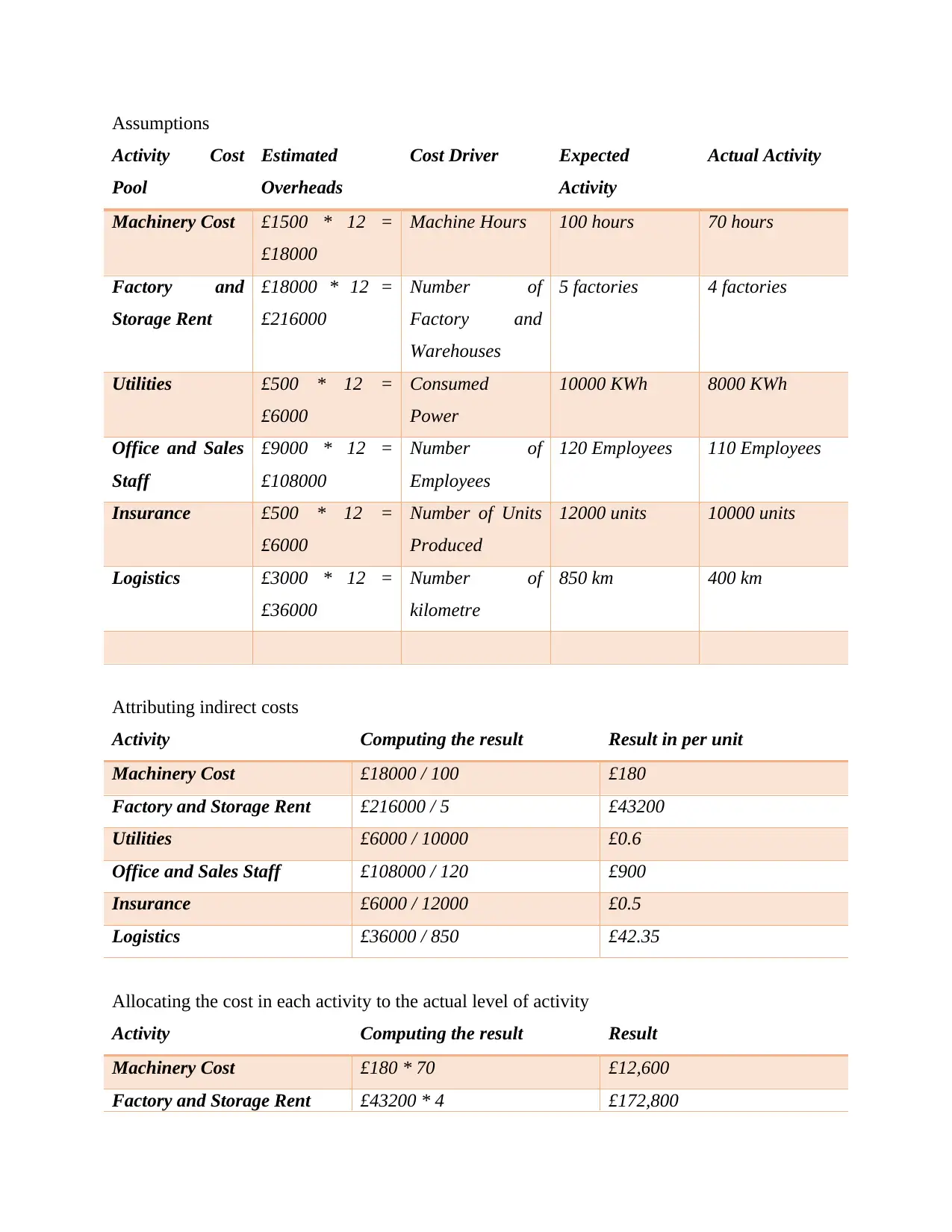
Assumptions
Activity Cost
Pool
Estimated
Overheads
Cost Driver Expected
Activity
Actual Activity
Machinery Cost £1500 * 12 =
£18000
Machine Hours 100 hours 70 hours
Factory and
Storage Rent
£18000 * 12 =
£216000
Number of
Factory and
Warehouses
5 factories 4 factories
Utilities £500 * 12 =
£6000
Consumed
Power
10000 KWh 8000 KWh
Office and Sales
Staff
£9000 * 12 =
£108000
Number of
Employees
120 Employees 110 Employees
Insurance £500 * 12 =
£6000
Number of Units
Produced
12000 units 10000 units
Logistics £3000 * 12 =
£36000
Number of
kilometre
850 km 400 km
Attributing indirect costs
Activity Computing the result Result in per unit
Machinery Cost £18000 / 100 £180
Factory and Storage Rent £216000 / 5 £43200
Utilities £6000 / 10000 £0.6
Office and Sales Staff £108000 / 120 £900
Insurance £6000 / 12000 £0.5
Logistics £36000 / 850 £42.35
Allocating the cost in each activity to the actual level of activity
Activity Computing the result Result
Machinery Cost £180 * 70 £12,600
Factory and Storage Rent £43200 * 4 £172,800
Activity Cost
Pool
Estimated
Overheads
Cost Driver Expected
Activity
Actual Activity
Machinery Cost £1500 * 12 =
£18000
Machine Hours 100 hours 70 hours
Factory and
Storage Rent
£18000 * 12 =
£216000
Number of
Factory and
Warehouses
5 factories 4 factories
Utilities £500 * 12 =
£6000
Consumed
Power
10000 KWh 8000 KWh
Office and Sales
Staff
£9000 * 12 =
£108000
Number of
Employees
120 Employees 110 Employees
Insurance £500 * 12 =
£6000
Number of Units
Produced
12000 units 10000 units
Logistics £3000 * 12 =
£36000
Number of
kilometre
850 km 400 km
Attributing indirect costs
Activity Computing the result Result in per unit
Machinery Cost £18000 / 100 £180
Factory and Storage Rent £216000 / 5 £43200
Utilities £6000 / 10000 £0.6
Office and Sales Staff £108000 / 120 £900
Insurance £6000 / 12000 £0.5
Logistics £36000 / 850 £42.35
Allocating the cost in each activity to the actual level of activity
Activity Computing the result Result
Machinery Cost £180 * 70 £12,600
Factory and Storage Rent £43200 * 4 £172,800
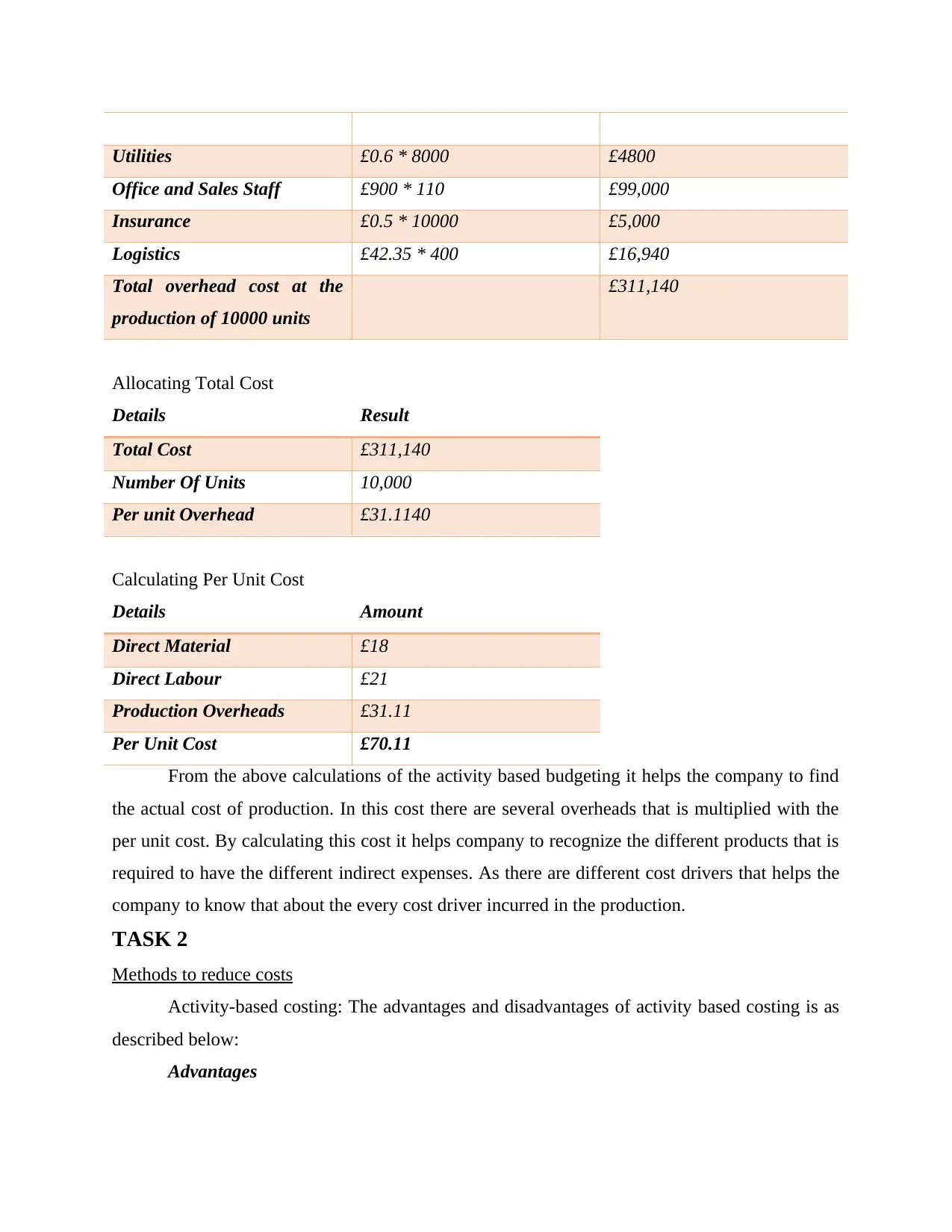
Utilities £0.6 * 8000 £4800
Office and Sales Staff £900 * 110 £99,000
Insurance £0.5 * 10000 £5,000
Logistics £42.35 * 400 £16,940
Total overhead cost at the
production of 10000 units
£311,140
Allocating Total Cost
Details Result
Total Cost £311,140
Number Of Units 10,000
Per unit Overhead £31.1140
Calculating Per Unit Cost
Details Amount
Direct Material £18
Direct Labour £21
Production Overheads £31.11
Per Unit Cost £70.11
From the above calculations of the activity based budgeting it helps the company to find
the actual cost of production. In this cost there are several overheads that is multiplied with the
per unit cost. By calculating this cost it helps company to recognize the different products that is
required to have the different indirect expenses. As there are different cost drivers that helps the
company to know that about the every cost driver incurred in the production.
TASK 2
Methods to reduce costs
Activity-based costing: The advantages and disadvantages of activity based costing is as
described below:
Advantages
Office and Sales Staff £900 * 110 £99,000
Insurance £0.5 * 10000 £5,000
Logistics £42.35 * 400 £16,940
Total overhead cost at the
production of 10000 units
£311,140
Allocating Total Cost
Details Result
Total Cost £311,140
Number Of Units 10,000
Per unit Overhead £31.1140
Calculating Per Unit Cost
Details Amount
Direct Material £18
Direct Labour £21
Production Overheads £31.11
Per Unit Cost £70.11
From the above calculations of the activity based budgeting it helps the company to find
the actual cost of production. In this cost there are several overheads that is multiplied with the
per unit cost. By calculating this cost it helps company to recognize the different products that is
required to have the different indirect expenses. As there are different cost drivers that helps the
company to know that about the every cost driver incurred in the production.
TASK 2
Methods to reduce costs
Activity-based costing: The advantages and disadvantages of activity based costing is as
described below:
Advantages
⊘ This is a preview!⊘
Do you want full access?
Subscribe today to unlock all pages.

Trusted by 1+ million students worldwide
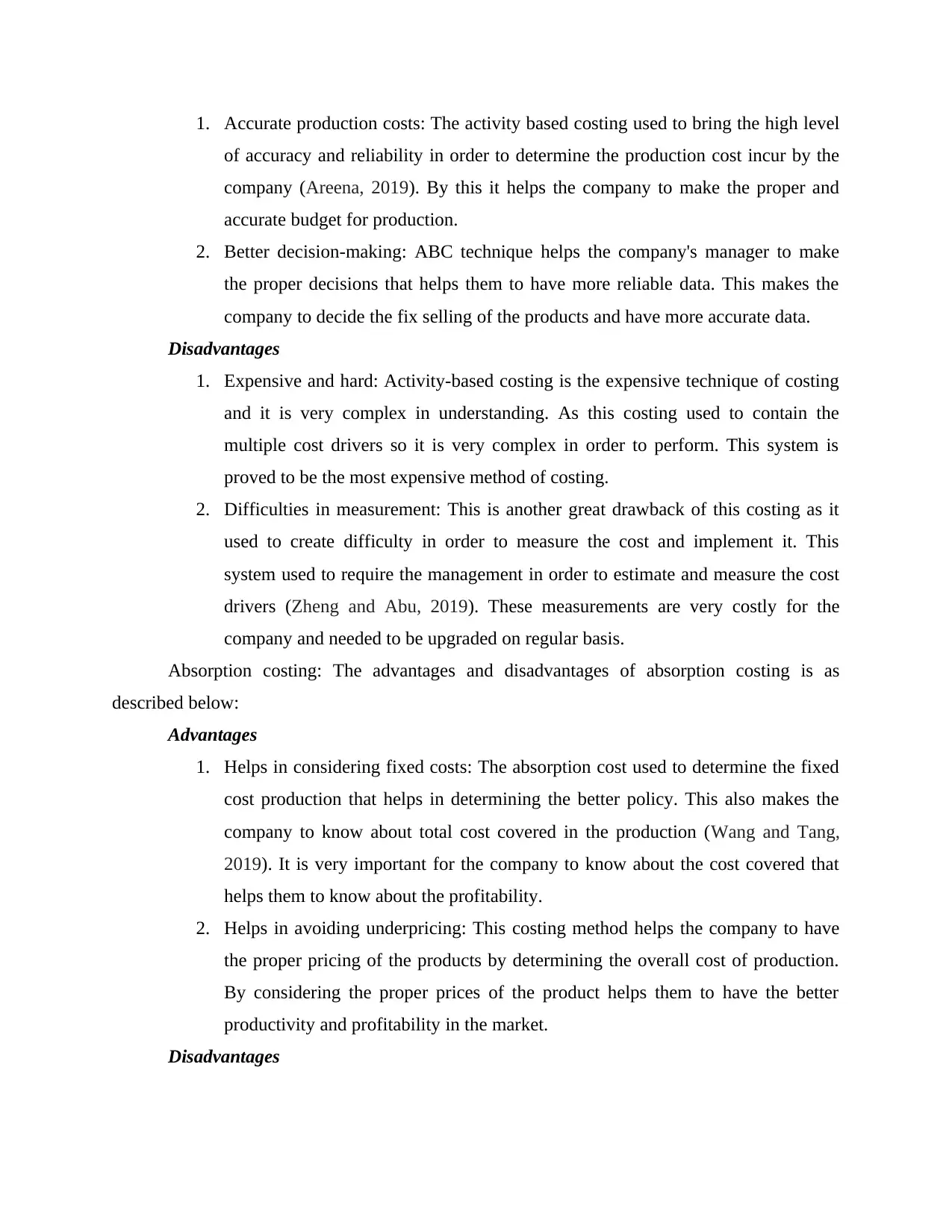
1. Accurate production costs: The activity based costing used to bring the high level
of accuracy and reliability in order to determine the production cost incur by the
company (Areena, 2019). By this it helps the company to make the proper and
accurate budget for production.
2. Better decision-making: ABC technique helps the company's manager to make
the proper decisions that helps them to have more reliable data. This makes the
company to decide the fix selling of the products and have more accurate data.
Disadvantages
1. Expensive and hard: Activity-based costing is the expensive technique of costing
and it is very complex in understanding. As this costing used to contain the
multiple cost drivers so it is very complex in order to perform. This system is
proved to be the most expensive method of costing.
2. Difficulties in measurement: This is another great drawback of this costing as it
used to create difficulty in order to measure the cost and implement it. This
system used to require the management in order to estimate and measure the cost
drivers (Zheng and Abu, 2019). These measurements are very costly for the
company and needed to be upgraded on regular basis.
Absorption costing: The advantages and disadvantages of absorption costing is as
described below:
Advantages
1. Helps in considering fixed costs: The absorption cost used to determine the fixed
cost production that helps in determining the better policy. This also makes the
company to know about total cost covered in the production (Wang and Tang,
2019). It is very important for the company to know about the cost covered that
helps them to know about the profitability.
2. Helps in avoiding underpricing: This costing method helps the company to have
the proper pricing of the products by determining the overall cost of production.
By considering the proper prices of the product helps them to have the better
productivity and profitability in the market.
Disadvantages
of accuracy and reliability in order to determine the production cost incur by the
company (Areena, 2019). By this it helps the company to make the proper and
accurate budget for production.
2. Better decision-making: ABC technique helps the company's manager to make
the proper decisions that helps them to have more reliable data. This makes the
company to decide the fix selling of the products and have more accurate data.
Disadvantages
1. Expensive and hard: Activity-based costing is the expensive technique of costing
and it is very complex in understanding. As this costing used to contain the
multiple cost drivers so it is very complex in order to perform. This system is
proved to be the most expensive method of costing.
2. Difficulties in measurement: This is another great drawback of this costing as it
used to create difficulty in order to measure the cost and implement it. This
system used to require the management in order to estimate and measure the cost
drivers (Zheng and Abu, 2019). These measurements are very costly for the
company and needed to be upgraded on regular basis.
Absorption costing: The advantages and disadvantages of absorption costing is as
described below:
Advantages
1. Helps in considering fixed costs: The absorption cost used to determine the fixed
cost production that helps in determining the better policy. This also makes the
company to know about total cost covered in the production (Wang and Tang,
2019). It is very important for the company to know about the cost covered that
helps them to know about the profitability.
2. Helps in avoiding underpricing: This costing method helps the company to have
the proper pricing of the products by determining the overall cost of production.
By considering the proper prices of the product helps them to have the better
productivity and profitability in the market.
Disadvantages
Paraphrase This Document
Need a fresh take? Get an instant paraphrase of this document with our AI Paraphraser
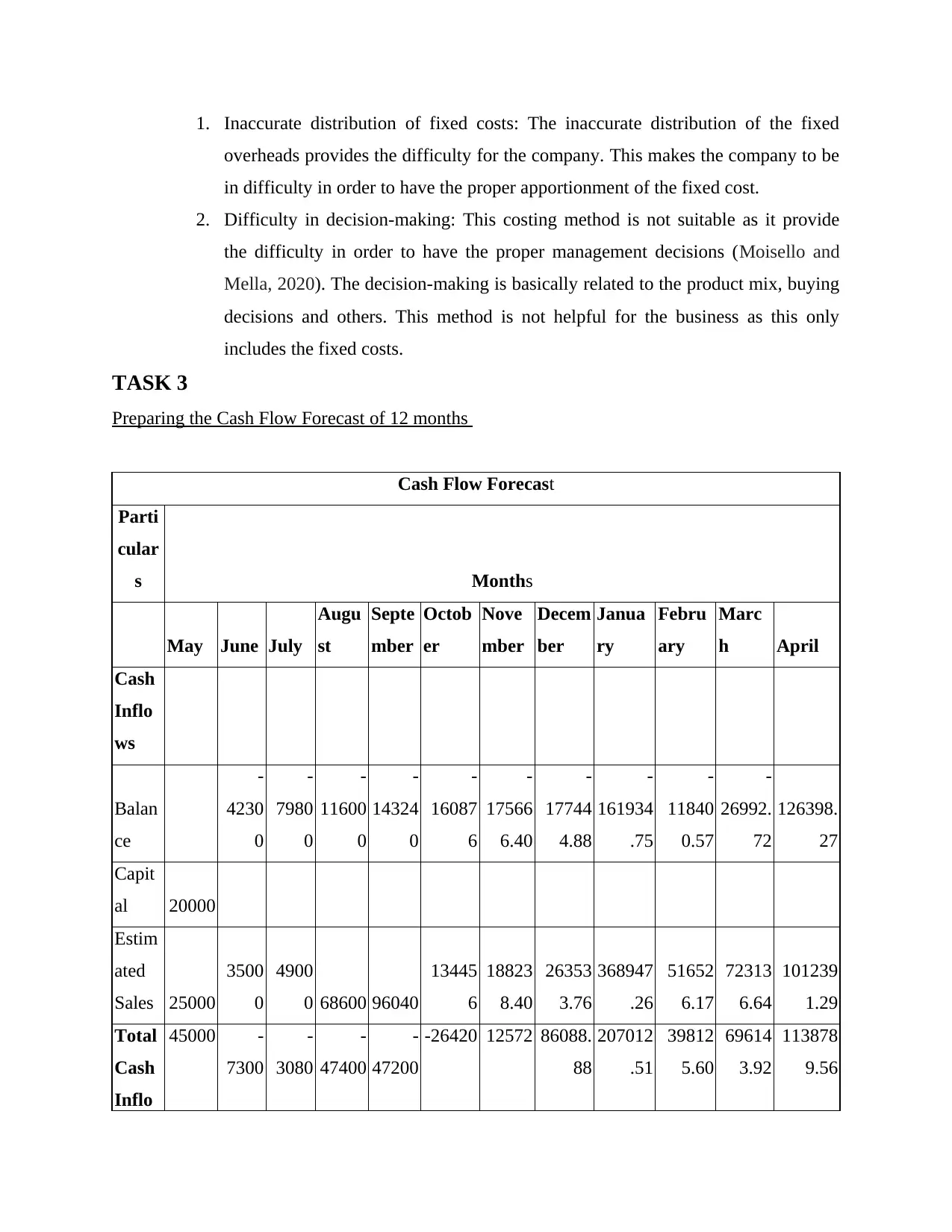
1. Inaccurate distribution of fixed costs: The inaccurate distribution of the fixed
overheads provides the difficulty for the company. This makes the company to be
in difficulty in order to have the proper apportionment of the fixed cost.
2. Difficulty in decision-making: This costing method is not suitable as it provide
the difficulty in order to have the proper management decisions (Moisello and
Mella, 2020). The decision-making is basically related to the product mix, buying
decisions and others. This method is not helpful for the business as this only
includes the fixed costs.
TASK 3
Preparing the Cash Flow Forecast of 12 months
Cash Flow Forecast
Parti
cular
s Months
May June July
Augu
st
Septe
mber
Octob
er
Nove
mber
Decem
ber
Janua
ry
Febru
ary
Marc
h April
Cash
Inflo
ws
Balan
ce
-
4230
0
-
7980
0
-
11600
0
-
14324
0
-
16087
6
-
17566
6.40
-
17744
4.88
-
161934
.75
-
11840
0.57
-
26992.
72
126398.
27
Capit
al 20000
Estim
ated
Sales 25000
3500
0
4900
0 68600 96040
13445
6
18823
8.40
26353
3.76
368947
.26
51652
6.17
72313
6.64
101239
1.29
Total
Cash
Inflo
45000 -
7300
-
3080
-
47400
-
47200
-26420 12572 86088.
88
207012
.51
39812
5.60
69614
3.92
113878
9.56
overheads provides the difficulty for the company. This makes the company to be
in difficulty in order to have the proper apportionment of the fixed cost.
2. Difficulty in decision-making: This costing method is not suitable as it provide
the difficulty in order to have the proper management decisions (Moisello and
Mella, 2020). The decision-making is basically related to the product mix, buying
decisions and others. This method is not helpful for the business as this only
includes the fixed costs.
TASK 3
Preparing the Cash Flow Forecast of 12 months
Cash Flow Forecast
Parti
cular
s Months
May June July
Augu
st
Septe
mber
Octob
er
Nove
mber
Decem
ber
Janua
ry
Febru
ary
Marc
h April
Cash
Inflo
ws
Balan
ce
-
4230
0
-
7980
0
-
11600
0
-
14324
0
-
16087
6
-
17566
6.40
-
17744
4.88
-
161934
.75
-
11840
0.57
-
26992.
72
126398.
27
Capit
al 20000
Estim
ated
Sales 25000
3500
0
4900
0 68600 96040
13445
6
18823
8.40
26353
3.76
368947
.26
51652
6.17
72313
6.64
101239
1.29
Total
Cash
Inflo
45000 -
7300
-
3080
-
47400
-
47200
-26420 12572 86088.
88
207012
.51
39812
5.60
69614
3.92
113878
9.56
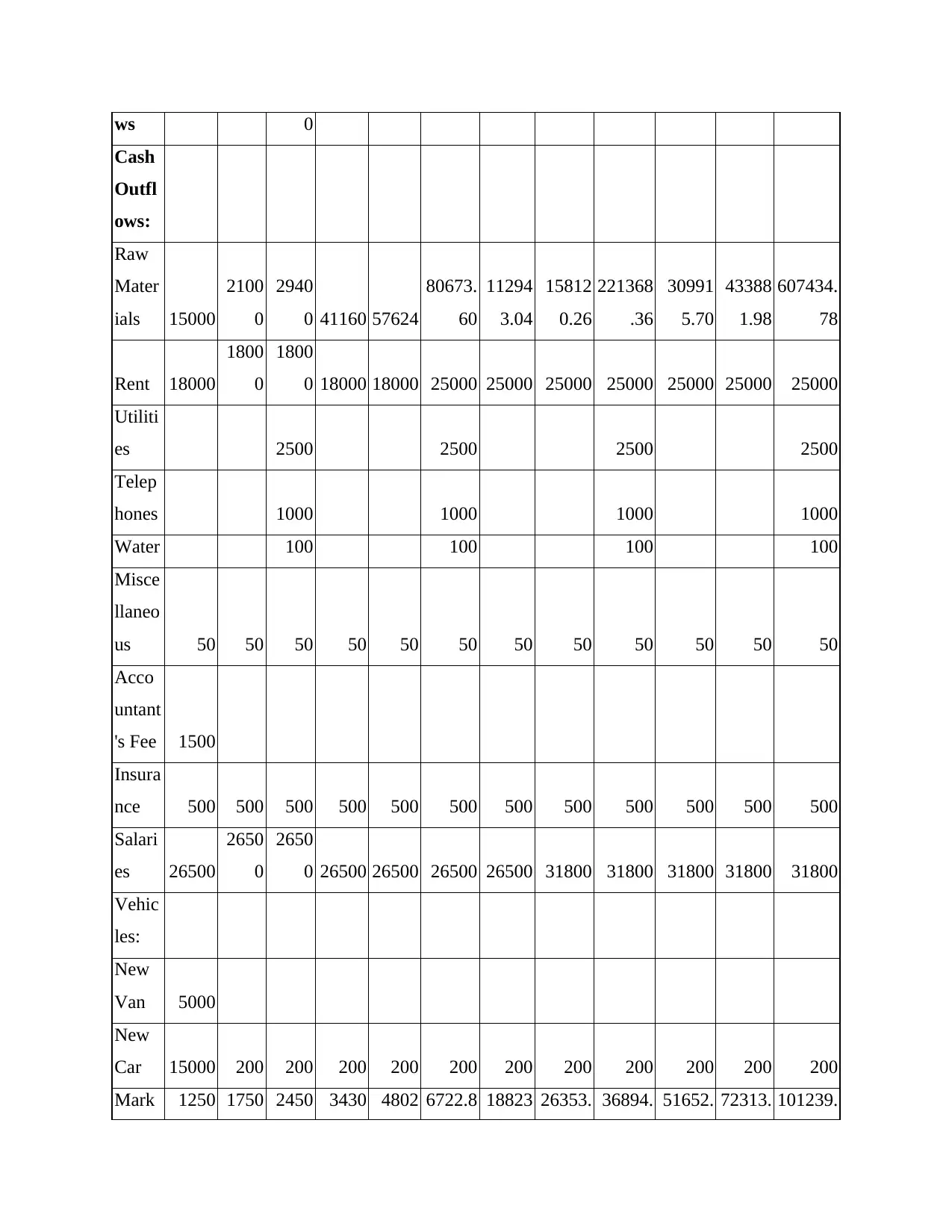
ws 0
Cash
Outfl
ows:
Raw
Mater
ials 15000
2100
0
2940
0 41160 57624
80673.
60
11294
3.04
15812
0.26
221368
.36
30991
5.70
43388
1.98
607434.
78
Rent 18000
1800
0
1800
0 18000 18000 25000 25000 25000 25000 25000 25000 25000
Utiliti
es 2500 2500 2500 2500
Telep
hones 1000 1000 1000 1000
Water 100 100 100 100
Misce
llaneo
us 50 50 50 50 50 50 50 50 50 50 50 50
Acco
untant
's Fee 1500
Insura
nce 500 500 500 500 500 500 500 500 500 500 500 500
Salari
es 26500
2650
0
2650
0 26500 26500 26500 26500 31800 31800 31800 31800 31800
Vehic
les:
New
Van 5000
New
Car 15000 200 200 200 200 200 200 200 200 200 200 200
Mark 1250 1750 2450 3430 4802 6722.8 18823 26353. 36894. 51652. 72313. 101239.
Cash
Outfl
ows:
Raw
Mater
ials 15000
2100
0
2940
0 41160 57624
80673.
60
11294
3.04
15812
0.26
221368
.36
30991
5.70
43388
1.98
607434.
78
Rent 18000
1800
0
1800
0 18000 18000 25000 25000 25000 25000 25000 25000 25000
Utiliti
es 2500 2500 2500 2500
Telep
hones 1000 1000 1000 1000
Water 100 100 100 100
Misce
llaneo
us 50 50 50 50 50 50 50 50 50 50 50 50
Acco
untant
's Fee 1500
Insura
nce 500 500 500 500 500 500 500 500 500 500 500 500
Salari
es 26500
2650
0
2650
0 26500 26500 26500 26500 31800 31800 31800 31800 31800
Vehic
les:
New
Van 5000
New
Car 15000 200 200 200 200 200 200 200 200 200 200 200
Mark 1250 1750 2450 3430 4802 6722.8 18823 26353. 36894. 51652. 72313. 101239.
⊘ This is a preview!⊘
Do you want full access?
Subscribe today to unlock all pages.

Trusted by 1+ million students worldwide
1 out of 17
Related Documents
Your All-in-One AI-Powered Toolkit for Academic Success.
+13062052269
info@desklib.com
Available 24*7 on WhatsApp / Email
![[object Object]](/_next/static/media/star-bottom.7253800d.svg)
Unlock your academic potential
Copyright © 2020–2025 A2Z Services. All Rights Reserved. Developed and managed by ZUCOL.




